Trump administration unconstitutionally targeted noncitizens over pro-Palestine protest, judge rules
Rümeysa Öztürk’s attorneys, on the same day, argue in her habeas lawsuit before a court of appeals that the Trump administration violated her First Amendment rights.
On Tuesday, a federal judge in Massachusetts ruled that the Trump administration had illegally used the threat of deportation to silence noncitizens in higher education who protested the war in Gaza in support of Palestine. In his ruling, U.S. District Judge William G. Young reiterated evidence and information surrounding the government’s decision to revoke several F-1 student visas, including that of Tufts graduate student Rümeysa Öztürk.
The plaintiffs — the American Association of University Professors — argued that President Donald Trump’s administration employed an “ideological deportation policy” against noncitizen students who had engaged in pro-Palestine activism, violating their First Amendment rights.
Young wrote that while there may not have been an explicit policy to deport all pro-Palestine noncitizens, the federal government’s arrests were intended to create a chilling effect.
“This case -- perhaps the most important ever to fall within the jurisdiction of this district court -- squarely presents the issue whether non-citizens lawfully present here in United States actually have the same free speech rights as the rest of us,” Young wrote in his ruling.
“The Court answers this Constitutional question unequivocally, ‘yes, they do,’” he wrote.
On the same day as Young’s decision, the 2nd U.S. Circuit Court of Appeals heard several habeas corpus petition cases considering whether district courts can oversee claims by noncitizens over violations of their First and Fifth Amendment
rights, including a hearing for Öztürk’s own habeas lawsuit against the federal government.
Young did not issue an order in Tuesday’s case and stated in his ruling that he would set up a later hearing to issue some form of non-monetary relief for the plaintiffs.
Andre Watson, assistant director of the National Security Division of ICE, concluded in a referral letter to the secretary of state that by co-authoring the op-ed, Öztürk had associated in activity that “may undermine U.S. foreign policy by creating a hostile environment for Jewish students and indicating support for a designated terrorist organization.”
The Department of Homeland Security’s targeting of Öztürk, as noted in Watson’s referral letter, was based on her
see JUDGE, page 3

Medford demands clarity
on Tufts’ financial contributions to city
Ananya Shah and Julian Glickman Contributing Writer and Deputy News Editor
Efforts to access a Payment In Lieu Of Taxes agreement between Tufts and Medford have reignited discussions over the university’s role in its surrounding communities. Tufts, which is exempt from property taxes on most of its Medford/Somerville campus due to the Dover Amendment, a Massachusetts law that negotiates agreements with the two cities to make voluntary financial contributions as a substitute for taxes.
Nick Giurleo (LA’19), a candidate for Medford City Council and Tufts alumnus, told Medford residents on social media that the city had been unable to find a record of the latest PILOT agreement with Tufts, despite his public records requests and correspondence with the Medford Assessor’s Office and Collector/Treasurer departments.
Tufts pays Medford $450,000 for its main campus and $250,000 for the Joyce
see MEDFORD, page 3
COVID-19 vaccines remain accessible to Tufts community amid federal changes
Tufts health officials say they will continue recommending the COVID-19 and influenza vaccines for all Tufts community members, provided they do not have medical constraints, amid recent federal changes to vaccination policy.
In August, the Food and Drug Administration updated its guidance for this year’s COVID-19 vaccine, advising it only for people over the age of 65 or those at higher risk due to underlying health conditions.
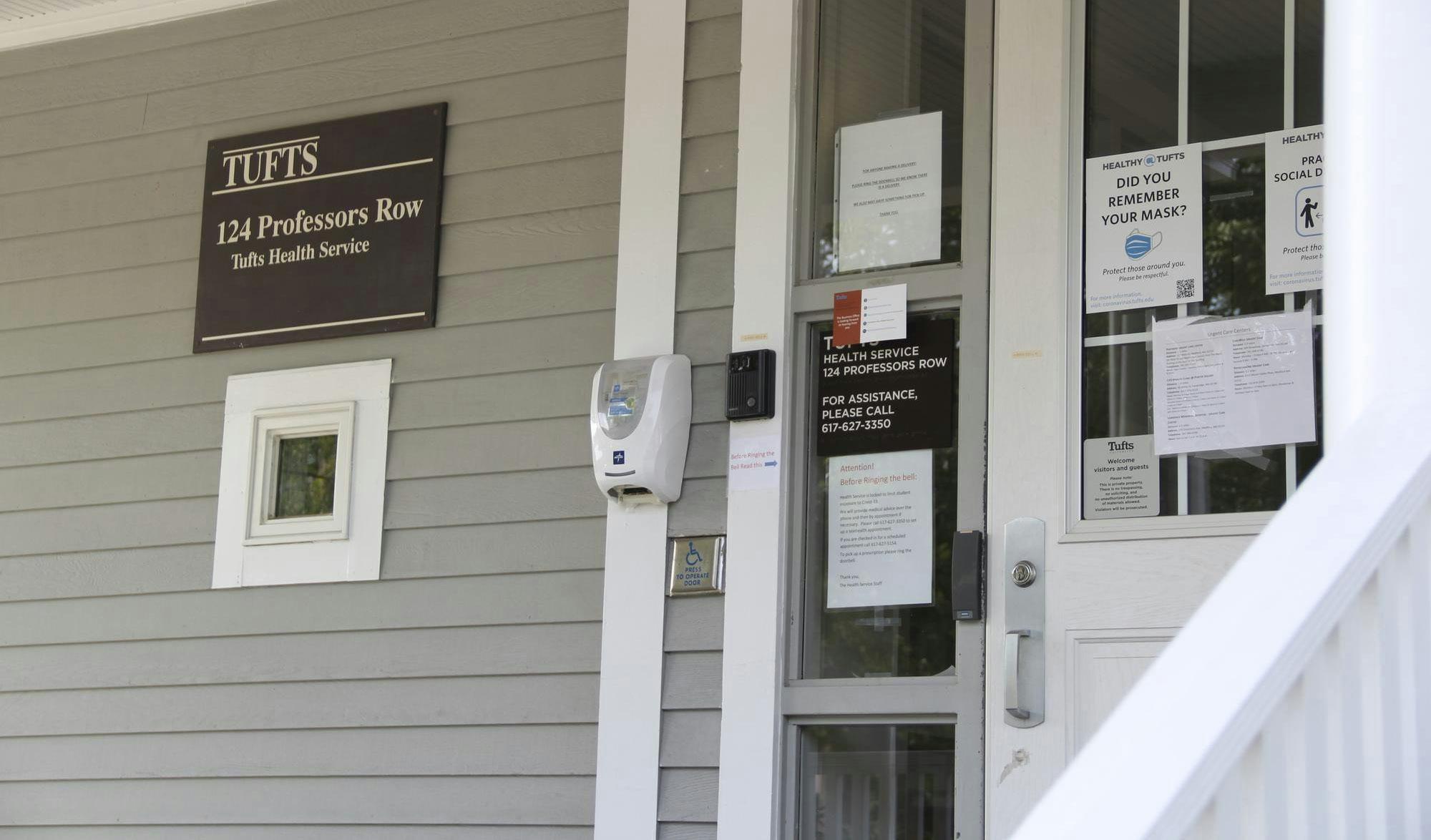
students have specific concerns or questions about getting vaccinated, they are welcome to consult with a provider at Health Service or with their own primary care provider.”
Caggiano confirmed that those under 65 years of age and those without high-risk conditions remain eligible to be vaccinated.
A spokesperson for the Massachusetts Department of Public Health told the Daily that they remained “hopeful” that students continue to get vaccinated in accordance with Massachusetts guidelines.
Caggiano also highlighted vaccine clinics being hosted this fall, which are available to all Tufts students, staff and faculty who want immunization.
Mixed messaging from federal agencies has also contributed to uncertainty. The Centers for Disease Control and Prevention and the Massachusetts
Medical professionals have raised concerns that receiving a vaccine could create barriers for those outside the recommended group, including difficulty finding providers willing to prescribe it and a possible lack of insurance coverage. Some insurance companies and professional groups, however, have confirmed that they will continue to cover updated COVID-19 vaccines with no cost-sharing between patients and insurance companies.
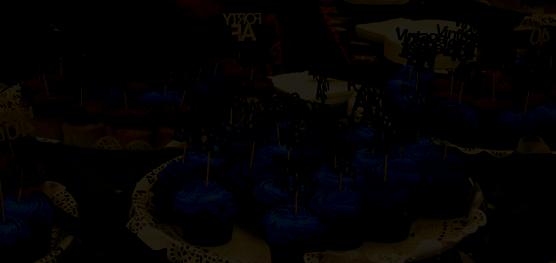




Department of Public Health, unlike the FDA, continue to recommend that everyone over 6 months old receive the updated COVID-19 vaccine.
Marie Caggiano, medical director of Tufts Health Service, said vaccines would continue to be offered by the university and remain covered across private health plans, Medicaid and Medicare.

“Tufts encourages all eligible community members to get vaccinated,” Caggiano wrote in a statement to the Daily. “If


At the clinics, vaccinations without a necessary prescription will be provided by trained pharmacists who are licensed to counsel and vaccinate in Massachusetts. They will take place on the Medford-
see VACCINE, page 2

Tufts humanities faculty research disrupted by federal funding changes
and Contributing Writer
Faculty research at Tufts has been limited by the cancellation of grants and the withdrawal of research funding across the country since President Donald Trump took office last winter. These changes, following the shuttering of federal agencies and shifts in research priorities by the federal administration, have left faculty members in humanities departments are facing uncertainty with limited institutional support.
One professor at the Friedman School of Nutrition Science and Policy who was granted anonymity to avoid retribution when applying for future federal grants, discussed their experience with losing funding as a result of the closure of USAID. While their research has not stopped entirely, it has become limited in its scope.
“There’s absolutely no money for travel, there’s no money for hiring research assistants. There’s no money for basically collecting new information, unless it can be done remotely,” the professor said.
They noted that this impact extends to the humanitarian sector as a whole.
“It’s not so much about research, per se, as it is about the loss of experienced people from the humanitarian sector,” the professor said. “It has a huge impact on the ability of our sector to provide services to people that have been caught in disasters or conflicts.”
The Friedman School has responded to the recent funding gap with changes to educational programs, such as shifting the Master of Arts in Humanitarian Assistance program from a oneyear, master’s program on-campus to an online course. This change is intended to minimize costs and potential visa issues for students, many of whom are from countries afflicted by conflict or disaster.
“I personally don’t think that the quality of the experience is
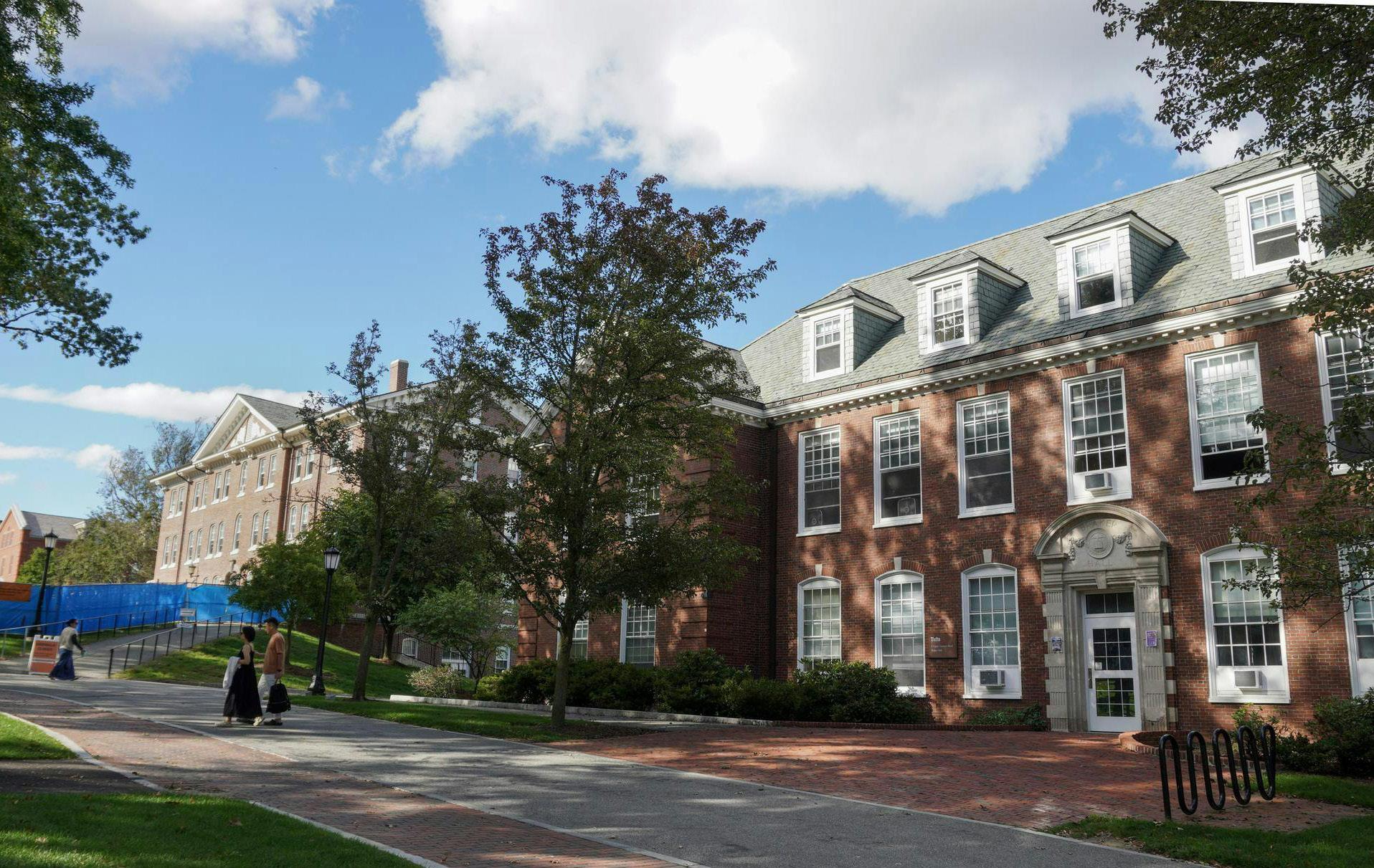
quite as good for people if it’s online compared to if it’s in person,” the professor said. “If that program is successful in bringing in more students, then obviously that will help to defray some of the costs.”
Researchers have also begun looking overseas for possible sponsors. However, according to the professor, even European companies have begun cutting back on grants, further placing researchers in a difficult position.
Packard Professor of Theology Brian Hatcher has also been affected by federal funding changes. He had been awarded a grant from the National Endowment for the Humanities and had been planning to take the next academic year off teaching to work on his next book.
Last spring, Hatcher received communication informing him that he had lost his NEH grant. He had applied for other grants, which gave him the opportunity to take a month-long fellowship this semester.
Hatcher met with staff in the Office of the Vice Provost for Research, who told him they were unable to make up for the lost funding the NEH grant would have provided him.
“They took meetings with us to see what our situation was, [but] they couldn’t offer, weren’t willing to offer, any compensation or anything, but they certainly understood and felt the pain and the sort of injustice of it,” Hatcher said.
Hatcher also thinks that the cancellation of NEH grants will have negative impacts for anyone early on in their career.
“For them, it might mean the difference between getting out their first book, and the first book in academia is usually the key to getting tenure and promotion at your institution,” Hatcher said.
In April, the NEH began rescinding grants already promised to researchers, arts programs and cultural groups. The agency announced in April that it cancelled awards that focused on diversity, equity and inclusion and environmental justice.
Additionally, it cancelled awards that it claimed “may not inspire public confidence in the use of taxpayer funds.”
“It’s a kind of attempt to shut down the very lifeblood of the university, which is to ask those tough, historical and critical questions, and promote discourse and conversation
and argument from all sides,” Hatcher said.
According to Julia Svoboda, chair of the Department of Education and president of the Tufts chapter of the American Association University Professors, Tufts has not committed to a general policy to respond to funding uncertainty.
“The pace of how cuts are announced, the legal battles, and the lack of a clear policy from the university for how it will support faculty all contribute to this uncertainty,” Svoboda wrote in a statement to the Daily.
She added that local members of the AAUP have been gathering information about faculty members impacted by grant cancellation and advocating for a voice in university leadership. Svoboda also called on university leadership to support faculty.
“I think there is a reluctance to commit to a policy of support given the uncertainty of what is to come,” Svoboda wrote. “Still, we see these cuts as an opportunity to show that Tufts will not allow its faculty’s research agendas to be set by the whims of an authoritarian and anti-intellectual administration.”
COVID-19 vaccines will be available on campus over the next month
VACCINE continued from the front
Somerville campus from Oct. 20–24 and on the School of the Museum of Fine Arts campus Nov. 13.
Caggiano remains hopeful that there will be a high rate of vaccination within the student population this year. Data on student vaccination this year is limited, but Caggiano says there could be repercussions if the number of immunizations decreases.
“Students may be at increased risk of contracting contagious illnesses like COVID-19 and flu due to living in congregate settings, and frequent close contact with others,” Caggiano wrote. “Getting
sick can cause significant disruptions due to absences from classes and work and puts students at risk for complications such as pneumonia and long COVID.”
Sophomore Liv Kronenfeld expressed worries that the new regulations could cause fewer people to choose to get vaccinated.
“Vaccines exist for a reason,” she said. “Shots suck and they aren’t very fun, but being vaccinated is really important.”
Kronenfeld also highlighted the effect getting vaccinated has on the health of those around her.
“Having accessible vaccines and healthcare is so important,” she said. “Even if I am less at risk than somebody else, me
not being vaccinated means that I’m more likely to get this disease and pass it to somebody close to me and so everybody being vaccinated helps everybody else.”
Sophomore Madeleine Owen agreed with the FDA’s new regulations, given that people above the age of 65 are more susceptible to the virus and more at risk for serious complications. However, she emphasized the importance of insurance coverage and agreed with the effectiveness of herd immunity.
“[If] the vast majority of people get a vaccine, [the next] strain of COVID won’t run through the general school,” Owen said. “Every single random sickness does run through our school
really quickly. If you can prevent that, then that’s good.”
Owen said she was not surprised by the conflicting messaging between the CDC and FDA because of the general political climate. However, she would follow the CDC’s suggestions surrounding the new vaccine because they focus specifically on pandemics.
Owen noted that communication about university clinics reminds students to be aware of their health and well-being.
“I feel like we forget about basic taking care of ourselves and so [getting vaccinated is] one of the things that should be like, ‘Hey, go do this,’” Owen said. “You kind of need this to function.”
Boston judge finds that Ozturk
and
others’ First Amendment rights were violated by federal government
co-authorship of an op-ed opposing Tufts’ investments in Israel — a viewpoint shared by Tufts Students for Justice in Palestine. Tufts SJP was suspended in November 2024 for sharing images of weapons and calls for an intifada.
Stuart Wilson, deputy assistant secretary for visa services in the U.S. Bureau of Consular Affairs, prepared an action memo that recommended the State Department silently revoke Öztürk’s F-1 student visa, while admitting that no evidence was provided to show she had participated in any antisemitic activity.
“Although information provided by DHS/HSI/ICE does not establish any potential ineligibility for Öztürk, you may in your discretion and in accordance with Department policy in 9 FAM 403.11-5(B), approve revocation of her F-1 visa effective immediately based on the totality of the circumstances,” Wilson concluded in the action memo.
In a hearing on July 9, ICE official Peter Hatch testified that the agency had used Canary Mission, whose goal is to “document individuals that promote hatred of the USA, Israel and Jews,” for leads in its investigation of noncitizen pro-Palestine student activists.
DHS officials instructed Hatch and a new team to compile a list of students who had engaged in pro-Palestine activism using profiles on Canary Mission, including that of Öztürk.
Young wrote that the intention of the administration’s targeting of noncitizens who had engaged in behavior it deemed to be antisemitic was to silence future pro-Palestine student protests and infringe upon their First Amendment rights, something that Öztürk is now fighting
Absence
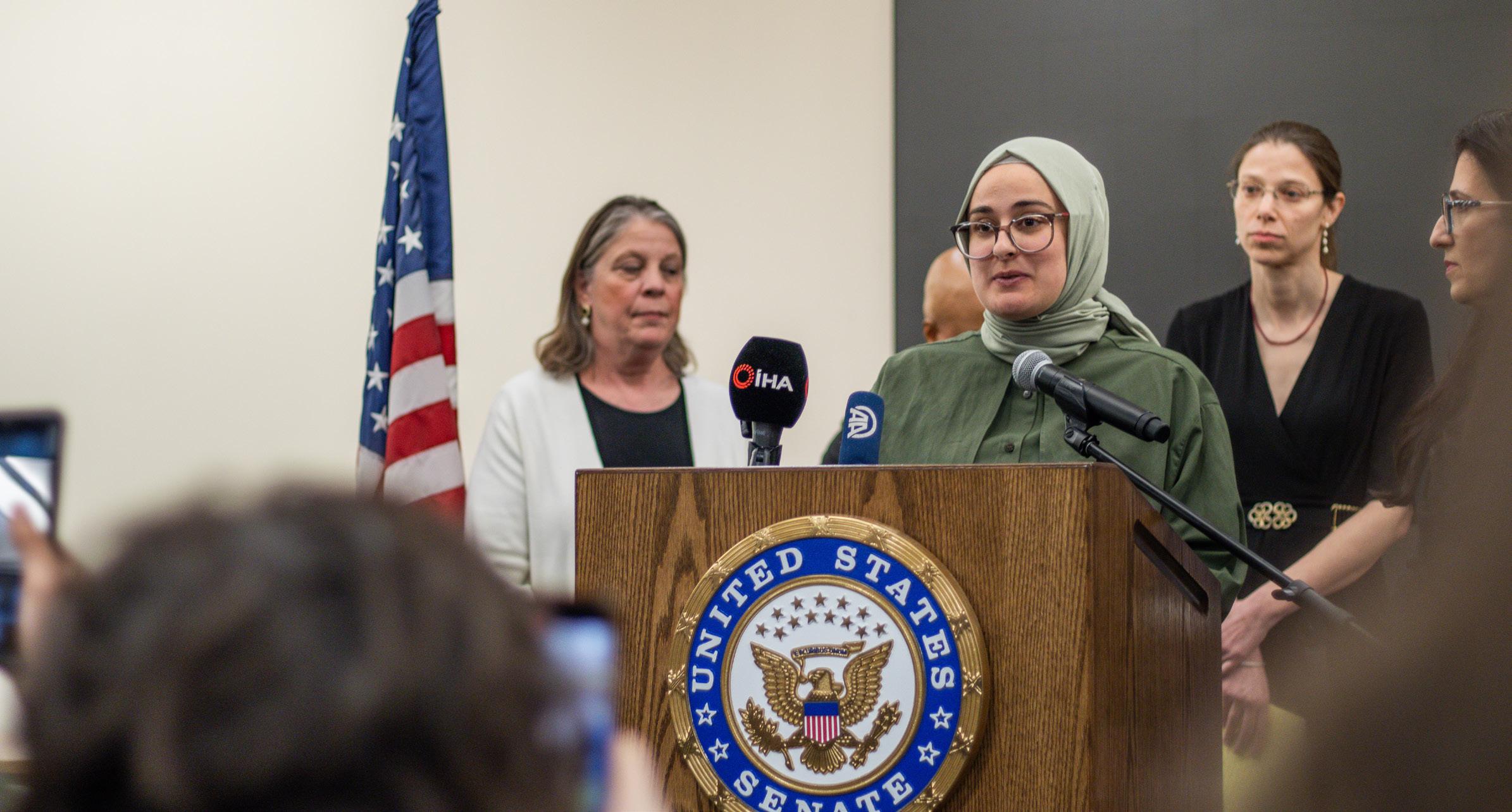
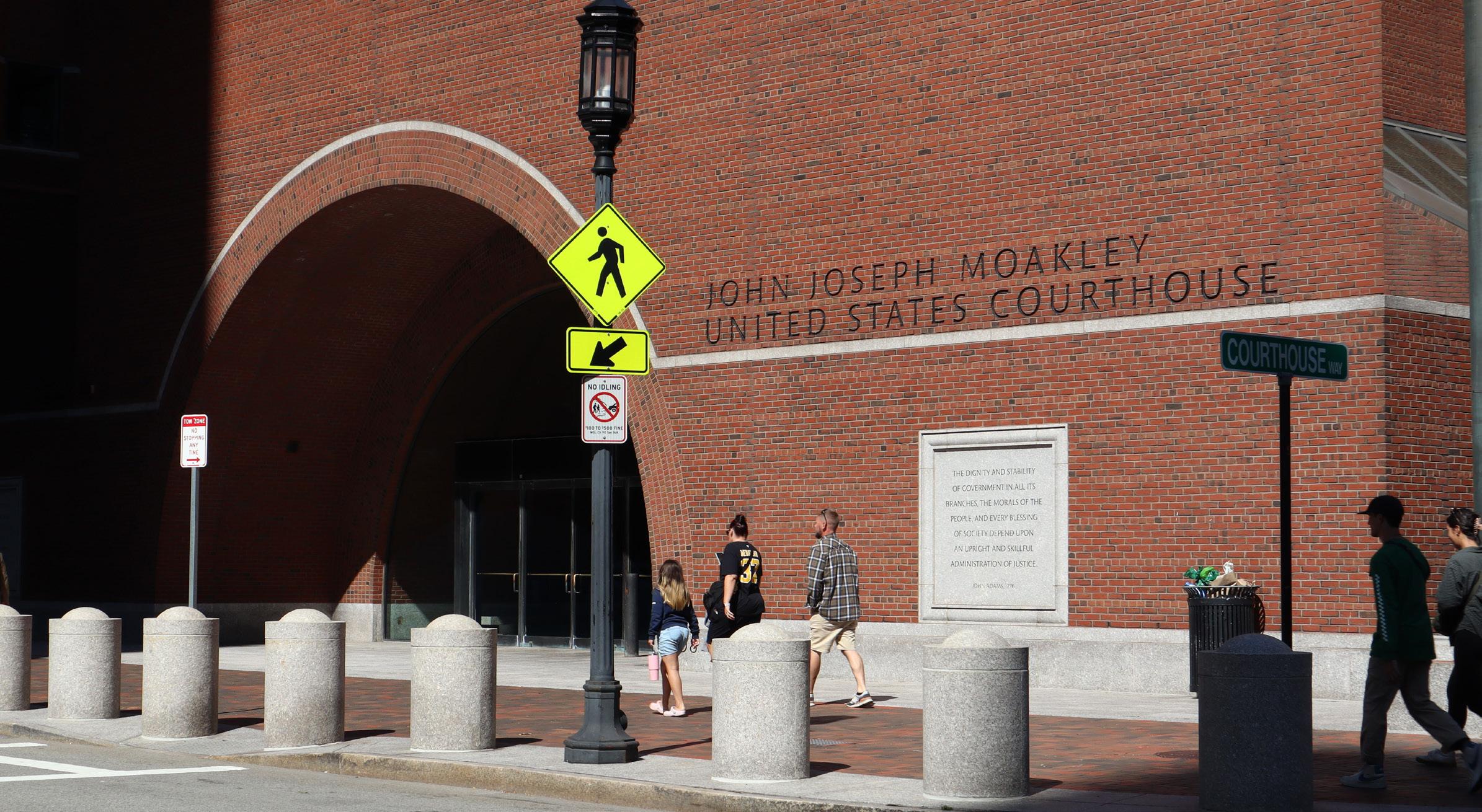
of new physical PILOT agreement from Tufts causes alarm in Medford
between Medford and Tufts, which is very alarming to me.”
-Cummings Center, according to Rocco DiRico, associate vice president for government and community relations at Tufts.
DiRico wrote in a statement to the Daily that the university also pays $759,100 in “annual property taxes on buildings in Medford,” as well as over $5.8 million in “annual community benefits to Medford and Somerville.”
However, the latest PILOT agreement, negotiated in 2018, was a verbal agreement without any written record, according to Giurleo’s conversations with DiRico.
“This was really the big revelation, that it was never memorialized in writing. There isn’t another written agreement,” Giurleo said. “This was essentially a handshake deal
Giurleo said he began trying to obtain the PILOT agreement in order to address divisions between the Medford community and Tufts.
“Growing up in Medford, before I went to Tufts, one thing I noticed was that there seemed to be a divide between people who live in Medford, grow up in Medford, and then the campus itself as its own entity,” Giurleo said.
Zac Bears, president of the Medford City Council, agreed with the sentiment behind Giurleo’s efforts and said residents wanted to see Tufts “be a better neighbor.”
“We’re not a host community, we’re a city,” Bears said.
“We’re the city where Tufts exists, and I think a lot of people feel that the city doesn’t have a fair deal with Tufts right now — that Tufts gets to
not contribute as much as it should to our shared well-being as a community.”
Bears has long advocated for a fairer PILOT agreement, holding community meetings as a resident and advocating for state legislation that would make PILOT agreements mandatory. He has also advocated for a PILOT Commission, with members appointed by the mayor — who currently has chief negotiating power in discussions with Tufts — and approved by the city council in order to give the city wider representation.
“When Tufts talks about community benefits, they make all the decisions on that right now. I think a commission could talk about what community benefits we want to see,” he said. “What do we consider community benefits?
Not just Tufts stating that and
dictating that to the communities that they are a part of.”
DiRico said the university’s $450,000 payment to Medford in the most recent PILOT agreement was a 64% increase from the previous 2018 agreement.
“Tufts University values our multilayered partnership with the City of Medford,” DiRico wrote. “We are always happy to meet with key stakeholders in Medford and Somerville to find ways to expand our partnerships in both cities.”
The previous agreement, which was enacted in July 2013 and expired in June 2018, contained benefits for Medford High School students, including a waiver of the $70 application fee to Tufts and personal invitations to top students to apply to the university.
Giurleo said the lack of an official document memorializing the latest PILOT agreement
raised wider issues about transparency in Medford.
“You should be able to go onto Medford’s website, download the document and read it for yourself, so you can judge for yourself as a citizen or even a member of the Tufts community, or both, whether or not this is a good deal,” he said.
Although Bears and Giurleo are opponents in the upcoming November municipal election, both agreed that the issue was an opportunity to find consensus to push the city and Tufts to come to a fairer agreement that would give the city a strong source of revenue.
“Both the vision of ‘What does it look like for Tufts to be a good neighbor,’ and ‘How do we get Tufts to do that?’ are actually pretty similar across the board, even for folks who have disagreements on other issues,” Bears said.
ARTS & POP CULTURE
‘One Battle After Another’ is another masterstroke on revolution and autocratic paranoia from one of the great creatives of our time

Willa (Chase Infiniti), as seen by her large, protruding baby bump.
To accurately describe the scene of something as modern as the new Paul Thomas Anderson film, it’s necessary to tap the rewind button to early leftist, revolutionary politics. During the ’70s, we heard rallying cries — people holding onto any form of comfort so as to make the bad times less trying. In Gil-Scott Heron’s 1971 black liberation anthem, “The Revolution Will Not Be Televised,” he exclaims, “Green Acres, Beverly Hillbillies, and Hooterville Junction will no longer be so damn relevant.” The metaphor here hinges on Heron citing these 1960s television programs (“Green Acres,” “Beverly Hillbillies”) and their themes — rooted in hoisting wealth and perseverance in white America — as no longer relevant. These people, with their glorified existence, are still living beneath the corrupt government. While “One Battle After Another” delivers Heron’s comedic jabs at the 1960s government, it is instead applied under the dome of a Trumpist agenda. The movie turns into something beaming with dimension and intelligence, while also delivering laughworthy moments via outrageous allusion and mockery, much akin to Heron.
As a creative, Paul Thomas Anderson is no stranger to bringing us into these sprawling worlds of absurdity and amusement. “One Battle After Another” starts by introducing us to Bob Ferguson (Leonardo DiCaprio), a revolutionary working in tandem with his lover, Perfidia Beverly Hills (Teyana Taylor), as they raid and liberate detention centers for captured immigrants. Instantly, the film grasps at realworld problems that may make one quiver. Both of them are members of the French 75, spearheading the guerilla tactics of the group. Perfidia remains a dominant, powerful stronghold of emotion. Her intensity is palpable and visually quantified at certain points. For instance, in one frame, she fires a rifle and withstands the recoil with biting vigor while pregnant with daughter
However, during confrontations with the defense forces of the detention centers, Perfidia meets Col. Steven J. Lockjaw (Sean Penn) — a person with the cliché snarl and horny whims of any great antagonist. Lockjaw develops a sexual desire for Perfidia which fashions his identity as the ‘nemesis’ of Ferguson. At this point, the film begins to seep more into the structure of its source material.
The film is viewed as a piece inspired by Thomas Pynchon’s “Vineland,” a novel about radicalized rebellion during both the Nixon and the Reagan administrations. The book, similar to this film, openly rejects conservatism and employs the toxicity of the men in power as a means to create a villain. Pynchon consistently harps on the corruption of mass media as a linchpin of corporate greed. Anderson frames his interpretation of society’s implosion under the Trump administration as one similarly based on mass media, but also sociopolitical repression. This is seen in his clear references to fascism and authoritarianism as the governing formulae leading the country.
In its entirety, “One Battle After Another” is something epic. It’s a project that one can assume Anderson has been trying to make for years. It moves fast and is packed to the brim with creative choices that are entrancing to a degree with which the director hasn’t yet trifled. Its depiction of 2020s California culture is new for Anderson. Rather than tap into modernity, many of his former great works allow us to escape into another time, one with less rules and more mischief. “Licorice Pizza” (2021), “Inherent Vice” (2014) and “Boogie Nights” (1997) are all famous examples. But this modern take is getting press and buzz to the likes he hasn’t seen before.
I liken this phenomenon to Martin Scorsese’s “The Departed” (2006), a contemporary eye into Boston mobster culture. After decades of directing and producing mafia chronicle after mafia chronicle, Scorsese
Elephant Yoga? A Jumbo Guide to Boston’s Yoga Spots
Down Under School of Yoga
Fiona Hinrichsen
Founded by Justine Wiltshire Cohen in 2004 in a church basement in Newton Highlands, the Down Under School of Yoga stands as one of Boston’s most esteemed yoga studios. Cohen’s yoga journey began at a very young age. Her parents, both journalists, worked with the Dalai Lama’s community in India, teaching English to Tibetan monks. Cohen’s own teaching career has now spanned over two decades. Notably, while working in Washington, D.C., as an international human rights lawyer, she combined her passion for law and classical yoga to become the yoga teacher to the U.S. Supreme Court.
However, after marrying a federal prosecutor from Boston, she moved to Newton, Mass., and founded the Down Under School of Yoga. Initially, it was less of a company and more so just a group of friends dedicated to teaching and creating a space for yoga. However, since then, Down Under has experienced significant growth, opening new studios nearly every year, with locations in the Back Bay, South End, Central Square, Harvard Square, Porter Square and Newton, offering over 100 classes daily across all locations.
decided to go more current and made, awards-wise, the most successful project of his career. The film industry and its priority of the ‘now’ over the ‘then’ is fascinating.
Nonetheless, Paul Thomas Anderson has managed to make a film that’s exceedingly impressive. It’s a film that also infuses the stoner culture and the farcical characters that are staples in his works. There’s Benicio Del Toro as Willa’s karate sensei, a man armed with a healthy advocacy for the revolution — much like Bob; or Col. Lockjaw, someone who, alongside his willingness to get off on his social status, seethes at the idea of being a part of the storied Christmas Adventures Club — to boast his mannish nobility. It is, overall, a wonderful treasure trove of people and stories dug up by Anderson — one nugget at a time.
The progression of the plot is complemented by the awe-inspiring percussive sounds of Jonny Greenwood’s score. Yet again, the multi-instrumentalist has managed to make his collaboration with Anderson a fruitful one. Here, we have a diverse array of tempos that shimmer with rhythmic fluency. It’s a seamless component of the film.
At first, “One Battle After Another” seems poised to become an acidic piece of political satire. But, once the film continues, it blends politics with action thrills. It’s just as comedic in its commentary on society as it’s serious — much akin to Gil-Scott Heron writing his lyrics to tackle oppression with honesty, even if the truth can seem overthe-top. And just as Heron says ”Green Acres, Beverly Hillbillies, and Hooterville Junction" as a way of alluding to white America, so too the revolutionaries in the French 75 communicate in code — adding to their mockery of corruption and what society has become.
The movie is all about society and politics, brought together through the power of comedic satire amid all the chaos. Through all the potent themes, thrilling chases and amusing confrontations, Paul Thomas Anderson has crafted a more than worthy benchmark in his long and hallowed catalog.
The school’s offerings vary immensely, ranging from classes for 3-year-olds to 93-year-olds. A couple of decades ago, they also initiated a free yoga program for seniors and individuals with disabilities, genuinely striving to make yoga accessible to everyone. Another unique facet of the studio is that it allows you to explore all three major lineages of yoga, tracing back to Krishnamacharya. Many consider him to be the father of modern yoga and some of his notable pupils — Pattabhi Jois, B.K.S. Iyengar and Deekshikachar, his son, — each developed unique styles: Ashtanga yoga, Iyengar yoga and therapeutic and meditative applications, respectively. The studio preserves the integrity of each tradition, intentionally avoiding blending methods to honor their distinct philosophies and techniques.
Starting Wednesday, the Down Under School of Yoga introduced reformer pilates classes, complementing their existing heated and non-heated yoga offerings. Beyond classes, the Down Under School of Yoga is dedicated to nurturing new teachers, guiding them to develop their own authentic yogi voice. This mentorship allows students to use resources –– including the yoga texts –– to further develop their practice.
Even during the pandemic, the school remeained committed to its community by maintaining all staff and management positions, paying living wages and providing top-tier benefits — a testament to Cohen’s passion and the studio’s community-oriented ethos. Newcomers can enjoy a special offer: four weeks of unlimited classes for only $49. For those planning to attend more frequently, the Yogi Pass is ideal, offering unlimited classes along with benefits such as a 20% discount at Life Alive Organic Cafe and additonal savings on massages, workshops and Ayurvedic consults. So, head over to their Porter Square location — just a shuttle ride and MBTA stop away — and give a class a try!
Fiona Hinrichsen is a sophomore studying international relations. Fiona can be reached at
The Hollywood-ification of Broadway

Recently, strolling down Broadway has felt more like scrolling through Netflix. Names like Daniel Craig, Keanu Reeves, Sarah Paulson, Eddie Redmayne, Kieran Culkin, Elle Fanning, Daniel Radcliffe, Rachel McAdams, Lola Tung, Nick Jonas and countless others have all been written in Broadway’s flashing lights over the past few years. MTA subway advertisements urge commuters not to miss Steve Carell in “Uncle Vanya” or George Clooney in “Good Night, and Good Luck” while Sandra Oh waltzes around the stage of a star-studded Shakespeare in the Park production for those lucky enough to possess coveted tickets.
Broadway is no stranger to stardom — it has produced its fair share of Barbara Streisands and Jonathan Groffs — and celebrity casting has been present since the early 2000s. But the craze seems to have reached new
heights in the years following the pandemic. Screen actors have begun to replace lesser-known stage actors in lead roles across almost every recent Broadway production. The phenomenon isn’t limited to Broadway stages, either. The Brooklyn Academy of Music presented Paul Mescal in “A Streetcar Named Desire” last spring, and both “Euphoria” actress Maud Apatow and “Modern Family” star Sarah Hyland stepped into the role of female lead Audrey in an off-Broadway revival of “Little Shop of Horrors.” Celebrity casting occurs so often that Broadway.com even has a subsection entitled “Stars on Stage” to make it easier for people to find the shows that feature their favorite movie stars.
The sheer quantity of A-listers in the theater has unsurprisingly sparked controversy. In the debate over whether Hollywood celebrities belong on Broadway stages, one major argument dominates
the defense of their increased presence: They bring in the bucks. Many believe that the allure of Hollywood stars has helped theaters draw audiences back in a post-COVID-19 economy. In an article investigating Hollywood’s role in Broadway, Rosa Sanchez, senior news editor at Harper’s Magazine, writes that many find themselves “plagued with entertainment opportunities and anxious about spending money” after the pandemic.
To compete with streaming services that feature A-listers on demand, theaters have turned to a competitive alternative: the chance to see them live. And their strategy seems to be working. Three of the 2024–25 season’s highest-grossing shows — “The Picture of Dorian Gray” (starring Sarah Snook), “Othello” (Denzel Washington and Jake Gyllenhaal) and “Good Night, and Good Luck” (George Clooney) — all featured celebrities. Additionally, “Good Night, and Good Luck,” “Othello”
and “Glengarry, Glen Ross” (Kieran Culkin and Bob Odenkirk) were the shows with the highest average paid admissions of the season. Without these celebrity headliners, this season’s average admission price would have been $125.03 — which is $3.40 less than the 2022–23 season.
Furthermore, the outliers — those with significantly greater average paid admission — from the past few seasons almost always featured celebrities in their casts. For 2023–24, it was “Merrily We Roll Along” (Daniel Radcliffe and Jonathon Groff) and “Cabaret” (Eddie Redmayne). The year before, it was “The Music Man,” with leading man Hugh Jackman.
The 2024–25 season now holds Broadway’s all-time record for highest gross at a whopping $1.89 billion, a record previously held by the 2018-19 season with around $1.83 billion. Without the celebrity component, it’s clear that Broadway may not have staged such a comeback.
Despite celebrities’ financial help, many still doubt their place on Broadway. Some believe their presence is a classic example of stunt casting — the practice of hiring big names as a gimmick to attract paying customers — rather than an act of artistic integrity. It’s also my belief that it commoditizes the experience; a show’s creative value is eclipsed by its casting. The first thing mentioned about a given show is who you were lucky enough to see in it. Name-dropping celebrities seen on stage obscures the experience of the show itself and replaces it as the primary topic of conversation surrounding Broadway. There’s also the fact that celebrities aren’t being hired because there is a lack of local stage talent; rather, they are
Microdramas are taking over the television landscape
If you don’t have TikTok downloaded, you might not know what “His Nerd” is. But if you’ve doomscrolled long enough, chances are you’ve stumbled across an ad for a microdrama. Titles like “His Nerd” and “Loving My Brother’s Best Friend” have become ubiquitous online, enticing viewers with quick romance and melodramatic twists. By definition, microdramas are exactly what they sound like — short-form dramas. Each episode runs about two minutes, is shot vertically to fit a phone screen and is built around a punchy hook and a dramatic cliffhanger. Popular platforms for these microdramas include CandyJarTV, ReelShort and DramaBox.
Though they may feel like a sudden phenomenon, microdramas trace their roots back to China. Known as duanju — literally ‘short drama’ — the format surged in popularity around 2020, when streaming platforms and short-form video apps realized viewers wanted fast, bingeable stories that could be consumed on the go. According to
CNBC, China’s microdrama market reached close to $7 billion in 2024, even overtaking the national film box office in revenue.
From there, the model spread worldwide. Companies like ReelShort and DramaBox tailored storylines for Western audiences but preserved the same formula: rapid setups, intense romance and cliffhangers designed to keep viewers swiping through dozens of episodes at a time. Business Insider projects the microdrama market, excluding China, could reach nearly $3 billion by the end of this year.
So why are people watching? Part of the answer lies in how we already consume media. Just as TikTok transformed how we discover music, microdramas fit perfectly into scrolling culture. They’re quick, easy to follow and steeped in familiar tropes — wealthy CEOs, forbidden crushes, supernatural twists. Production efficiency also fuels the trend. A full microdrama can span 80 or more episodes, each just a couple of minutes long, shot quickly with small crews and simple sets. That speed and scale enable platforms to test ideas
cost-effectively and inundate audiences with new content, a sharp contrast to the years-long cycles of traditional television.
Perhaps what distinguishes microdramas most is that many apps use a ‘freemium’ model: After a few free episodes, viewers must pay with in-app currency, coins or a subscription to continue. According to Business Insider, about 75% of revenue from U.S. microdrama apps now comes from viewer payments under this model.
Though the duanju format that took hold in China is now influencing TikTok feeds worldwide, U.S. studios have adapted it for Western tastes. CandyJarTV, for example, specializes in short, romance-driven content, while ReelShort is experimenting with thrillers and fantasy alongside love stories.
Still, the rise of microdramas is not without critics. In China, regulators have condemned some shows as ‘low-brow’ or ‘vulgar,’ arguing that mass-produced melodramas dilute artistic value. In addition, commentary within China has criticized the reliance on recycled tropes — scheming mothers-in-law, exaggerated conflicts, unrealistic plot
replacing cultivated stage actors in major roles.
Behind the curtains, many Hollywood stars have also had a hand in the production process of Broadway shows. Prolific music producer Jack Antonoff composed songs for Sam Gold’s recent “Romeo + Juliet,” starring Rachel Zegler and Kit Connor. Likewise, Mindy Kaling, Mariah Carey and Angelina Jolie have all recently produced Tony-winning musicals, leading many to the conclusion that Broadway has grown a bit obsessed with Hollywood. Even some of the shows themselves are about celebrities: “MJ the Musical,” “Dolly: A True Original Musical,” “The Cher Show,” “Beautiful: The Carole King Musical,” “A Beautiful Noise” and “Tina: The Tina Turner Musical” are all examples of a newlypopular genre of musical biopics. Shows like these cover the pages of Broadway ticket websites, while long-running originals like “The Phantom of the Opera” have closed. It’s even hard not to feel cynical about Leslie Odom Jr.’s return to “Hamilton” when it now seems like a shameless financial appeal, regardless of his Broadway beginnings.
Seeing as Broadway is a hugely important part of the New York City economy, it’s crucial that it continue generating revenue and creating jobs. Simultaneously, we must wonder what is at risk for Broadway’s ‘real’ actors — and for the artistry and authenticity that the theater has long represented. After the COVID-19 pandemic, as Broadway seems to be a new career milestone for Hollywood actors and their names begin to replace smaller ones on playbills, the question begs to be asked: What are we willing to surrender to keep Broadway alive?

twists — and has expressed concern about oversaturation of similar storylines which may lead to audience fatigue. Some observers also warn that the rapid pace and formulaic structure of many microdramas undermine their artistic credibility. Despite all of that, the numbers suggest microdramas are here to stay. Platforms are branching into new genres and using TikTok and Instagram to funnel audiences directly into their apps. For traditional television, the shift is significant. Short-form dramas won’t replace prestige series, but they do
compete for audience attention — and ad dollars. As Time reported in a recent profile of ReelShort’s CEO, microdrama platforms can adjust storylines based on audience data in real time, a flexibility Hollywood networks can’t match.
Challenges remain: maintaining quality amid mass production, managing regulatory scrutiny and preventing burnout among viewers. But if current growth continues, microdramas could become not just a trend, but a permanent fixture in the global entertainment landscape.
Happy 40th birthday, Campus Center!
Editor’s Note: Antonia Toro is a staff writer for the Daily. Toro was not involved in the writing or editing of this article.
On Friday, students walking into the Mayer Campus Center lobby during the early afternoon were met with a surprising sight: blue balloons, an Italian ice stand, free T-shirts, succulent-pot painting stations and cupcakes galore. What could be the reason for all the pomp and circumstance?
“Today we are celebrating the 40th birthday of the Campus Center, just to get as many people packed in here to have a good time, to remind us of why we love the campus center and what a great joy it is for our students,” Sydney Grant, operations coordinator for the Office of Campus Life, said.
That’s right — the Campus Center recently celebrated entering her 40th year as what Grant described as the “beating heart” of Tufts.
“Her,” indeed — the building was not named after former Tufts University President Jean Mayer, as one might assume, but rather his wife, Elizabeth Van Huysen Mayer. According to her 2006 obituary, Mayer frequently gave back to both the Tufts and the Greater Boston community. Mayer’s passion was celebrating extracurricular activities and student life. Now, Tufts celebrates
Mayer’s legacy with a proper birthday party for the building named in her honor, complete with cake and ice cream. The frequency and spontaneity of pop-up events like these are part of the Campus Center’s enduring charm.
“There’s always something going on … in the vicinity of the Campus Center,” first-year Joseph Neusner said. “Sometimes you just wander into random events and notice cupcakes.”
Each student at the event had something unique to say about why they love the Campus Center.
“I think the Campus Center is such an amazing place for students to get together and have a lot of good laughs and memories,”
sophomore Lyla Sowder-Yuson said. “It’s so homey over here.”
“It’s so vibrant, there’s so many people around and good vibes,” sophomore Yuyang Xu said.
“I feel like it’s just such a center of activity and socialization,” firstyear Jonin Morgan said.
“I like how central on campus it is, especially with some classrooms being down[hill], some classes being up[hill] and then a lot of dorms being around here as well,” junior Alex Fial said. “A lot of people come to study and quickly get something [to eat] before they have to go to class.”
A key theme in students’ comments was, of course, the wide range of dining options in and around the Campus Center, including Pax et Lox Glatt Kosher
Deli, Hotung Café, Commons Marketplace and The Sink.
“There’s so [many] dining options, and I feel like it’s a really good place to gather around food and … hang out with your friends,” Morgan said.
Sophomore Antonia Toro expressed her love for The Sink, Tufts’ only entirely student-run cafe. The Sink is beloved among the student body for its stylish baristas, lively playlists and aesthetic lighting. Right now, the cafe is collaborating with the Tufts Association of Latin American Students to offer a specialty menu of Latinxinspired drinks. The cafe frequently collaborates with clubs and affinity groups to promote initiatives.
“I think my favorite thing about [the Campus Center] is probably The Sink and all the nice drinks that they have, especially now, because it’s Hispanic Heritage Month,” Toro said. “They have a collaboration with ALAS, and they’re doing a horchata and a lot of different drinks, so I think that’s really interesting and important for Tufts.”
While The Sink is arguably the most popular cafe in the Campus Center, the other options still have their fair share of devoted fans.
When asked about his favorite Campus Center dining option, Xu responded, “It’s got to be the Commons. … They just have food you can’t get anywhere else on campus.”
Sophomore Tim Chung is patiently awaiting for the return of Late Night at Commons, when the retail dining location accepts meal swipes from 9:30 p.m. to 12:30 a.m. on Friday and Saturday nights. In the meantime, his go-to spot in the Campus Center is Hotung.
“I like their açaí bowl,” Chung said.
Many students also appreciate the Campus Center for its variety of study spaces, whether it be the quiet tables on the top floor or the frequently-rambunctious seating area near the Commons.
“I really like coming here to study,” Toro said. “It’s not [as] serious as the library, [but] you can still get things done.”
“It [can be] different for what you need. [There are] the group study spots and also the solo lockin areas,” sophomore Ryan Yoo said. “Hotung is my favorite place to study on campus.”
Despite acknowledging the squeaky metal chairs in Hotung — a common grievance among Jumbos — Yoo remained firm in his commitment to the café.
Of course, the Campus Center would not be as amazing as it is if not for the dedicated students and staff who keep it running. Tufts Dining student employees like Fial are essential to the success of the retail locations.
“I’m working to celebrate her birthday,” Fial said. “I’m keeping her running.”
Joe Golia, director of campus life and official birthday party
organizer, emphasized the importance of Office for Campus Life workers in an email to the Daily.
“[The Campus Center is] open seven days a week approximately 118 hours and is always active and a wonderful place for students to eat, relax, meet or unwind. I think a lot of students past and current can reflect on positive memories from the Campus Center,” Golia wrote. “While I love it all, my favorite part is the OCL Office because of the staff, and especially our student employees.”
One of Golia’s responsibilities is to advise the Tufts Community Union Senate, the office of which is housed in Room 215 of the Campus Center. Junior Luc Brown cites the TCU office as one of the Campus Center’s many highlights. As the treasurer for Pen, Paint and Pretzels, Brown frequently depends on the designated space for TCU Treasury meetings.
“I also spend a lot of time here as a [club] treasurer,” Brown said. “Shout out the TCU Treasury and all the fun stuff that they do for all the clubs on campus.”
Considering all the reasons Jumbos love her, the Campus Center is clearly worth celebrating, and what could be more Tufts-esque than throwing a building a birthday party? As she enters her early forties, the CC has plenty of exciting events to come. Next time you walk by, consider popping into the CC and seeing what new things she has to offer.

TUFTS JACKSON JILLS TAKE THE STAGE AT BOSTON SYMPHONY ORCHESTRA
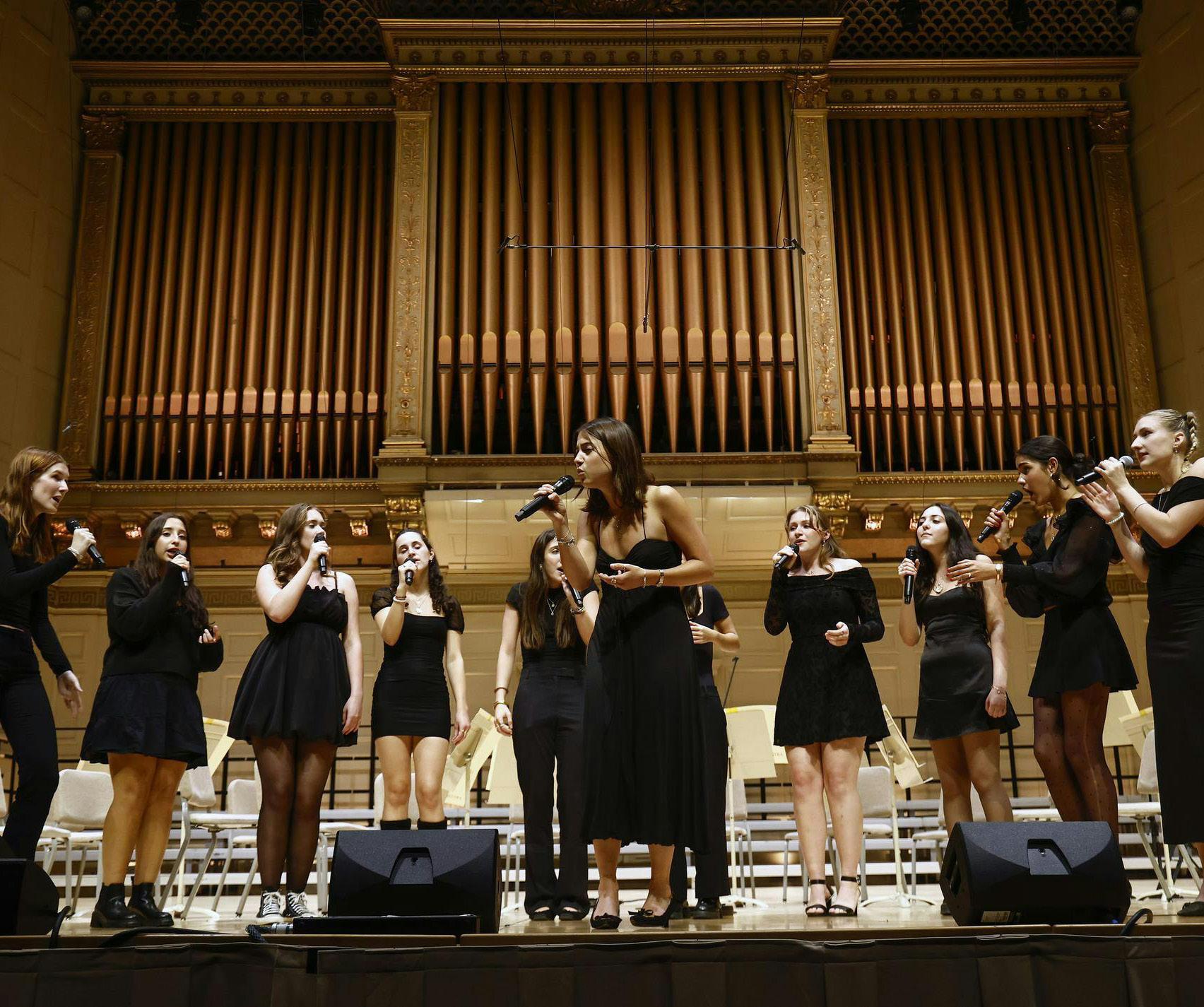
Traditional Chinese instruments paired with original electronic melodies, more than six cellos covering Coldplay’s “Viva la Vida” (2008) and Lorde’s “Green Light” (2017) are just a few highlights from the Boston Symphony Orchestra’s Sept. 18 event: “Music’s Next Generation — A College Showcase.”
This is the first year the Boston Symphony Orchestra has held this college showcase. In a statement to the Daily, the orchestra’s vice president of artistic planning, Anthony Fogg, noted that the event aimed to open the doors of the Symphony Hall to all, free of charge.
“As an organization with a long history of supporting emerging artists and a deep commitment to education and community engagement, we saw an opportunity to showcase some of the many talented young performers at all levels studying in Boston’s plethora of colleges and conservatories,” Fogg wrote.
While the performance solely highlighted collegiate music groups in the Boston area, the audience was reflective of all ages. Isaac Lee of
Medford and Anna Gurvich, a Somerville native, did not have specific connections to any one college group, but the two attended anyway.
“My mom’s visiting, so I wanted to bring her here and then look at the symphony hall and listen to some great music,” Lee said.
Gurvich, down for the adventure, added that she loves music and “supporting local musicians.”
Lee was appreciative of the far-reaching range of music that the students showcased.
“I was actually telling them in the middle of it feels like we’re on a world tour of all kinds of music, from India to China — I loved all of it,” he said. “It’s very interesting to see how they actually go from tradition to pop to fusion [it’s] very innovative [and] something that I wasn’t exactly used to, but loved it.”
Gurvich praised the dedication of all of the student groups from the evening.
“I want to commend all of these universities and these students that dedicate time in addition to their actual school obligations to being part of these groups to do something new, something different, and go out into the community and share their creative
inspiration and talent with everyone,” she said.
According to Nora Murphy, a sophomore in the Jackson Jills, the group was very excited to receive an offer to perform at Symphony Hall and accepted the chance quickly.
“We hadn’t gotten this opportunity before, and it’s very prestigious,” she said. “Being at the BSO, it’s a great venue. So it’s just awesome.”
Murphy, who joined the Jills in the fall of her first year, immediately felt welcomed by the friendly group and settled into their “cozy” rehearsal room. For Murphy, the Jills provide a very special and supportive community.
“I think it’s so important — and I didn’t realize the importance of it until I had it — having a female space, just like an all-female space, is really, really nice … and it’s another level of comfort that we don’t get in daily life,” she said.
Fortunately for Murphy, she gets to spend a lot of quality time with the Jills. The a cappella group rehearses seven hours a week and performs both on and off campus on the weekends. For the BSO show, the Jills gathered new and old songs from their repertoire.
Their performance incorporated many harmonies
throughout many of their songs — harmonies that do not exist in the original versions of these works. Their arrangements of Lorde’s “Green Light” (2017), Britney Spears’ “...Baby One More Time” (1999), Guns N’ Roses’ “Sweet Child O’ Mine” (1987) and Coldplay’s “The Scientist” (2002) featured countless layers that combined themselves into a full-bodied sound.
“We make our own arrangements, so we have a music director. And then, honestly, anyone who wants to be involved in arranging music can be,” Murphy explained. “As we’re rehearsing, we kind of go over dynamic stuff and [say], ‘Oh, we should add this,’ or, ‘We should do this.’”
Murphy does not lead the arrangement process, but she said that her friends who do make arrangements love to add their own personal element to a song.
“People can get really creative with it,” she said. “They listen to the song a million times, so it’s wired in their brain, and then put it in note by note. … I guess that’s where the creativity really sets in … you have to find a way to mimic the instruments or add your own thing. We [might] have a lot of echoing going on, or we
have a lot of cascades happening that aren’t in the song.”
Moments of this creativity shone through during each song. Every little sound, beat, melody or effect was accessible to the audience because each Jill sang into their own microphone. For Murphy, this was a highlight.
“We haven’t, or at least I haven’t, sung at a place that gives us all individual microphones. And so that was kind of special,” she said.
A surprising element of the show was the seating arrangement in the hall — rather than rows of theater chairs, there were small tables and chairs covering the floor. Murphy thought it made the environment “feel more special … [and] more personal.”
On stage, the Jills danced and swayed to the music as they sang. This was part of an intentional effort to stray away from their usual low-key energy, according to Murphy.
“I think this performance especially was super fun because … we’ve been trying to amp up the energy so the crowd feels more excited,” she said. “‘Sweet Child of Mine’ is especially fun. We can get silly there. And I think it was fun to do that in such a beautiful hall.”
Late Night At The Daily
Samantha: “No one looks at me the way Claire looks at this cake.”







HOROSCOPE






24-OCTOBER 23
Antithesis Ethicists
Love and friendships
Eric Frankel and Kate McAndrew
Inquiry:
Hi Kate! I have two very good friends, let’s call them Adam and Sally, who dated for a few months last year and broke up in January. Sally still has feelings for Adam, but Adam has said that he’s over her (although I’m not 100% that’s true). I’m close friends with both of them, but especially Adam. In the past, we’ve been so close that people have questioned Adam’s relationship with Sally, and I think there might have been some jealousy or nerves between me and Sally because of my friendship with Adam. Then, during finals season, I ended up kissing Adam a few times, and he helped me move out. But as the summer approached we decided to end things. I really want to maintain both friendships but I’m really nervous about how to do this!
Kate:
This is clearly a very delicate situation. I do think that you need to tell her at some point. But I don’t think it’s urgent. Keeping such a big secret from a close friend will be challenging and you might be on edge when you are around her. I think this could jeopardize the friendship more than telling her could.
Sally having suspicions about you and Adam’s relationship is another reason why I think you need to tell her. She has the right to know that, yes, something did happen, well after they broke up, and together you made the decision to not continue it. Not only will telling her let her trust you more, but it also might allow her to explore her lingering feelings for Adam. I’m sure that telling her will be uncomfortable and your friendship might seem rocky in the short run. But I do think that this is something that could get back around to her and I think it’s extremely important that you are the one to tell her.
But, like I said, it’s not urgent. Let the semester start and settle back into school. Then you will be better able to assess when you should tell her and how you should say it. I’d also recommend telling Adam that you are going to tell her.
Editorial: Defending free media starts with sustaining local news
The Editorial Board
On July 24, President Donald Trump’s Rescissions Act was signed into law, stripping over $1 billion in allocated funding from NPR and PBS and marking a dark day for public broadcasting. From providing educational programming like “Sesame Street” to delivering breaking news, public broadcasting has long served as an integral part of American life across all divides and is a vital resource to staying informed.
The defunding of public broadcasting comes at a perilous moment in journalism. In 2024, more than two newspapers closed per week across the country, and over 3,200 print newspapers have ceased operation since 2005. Local journalism has been hit particularly hard: A study found that over 1,500 U.S. counties have only one local news outlet. In Massachusetts, dozens of
Keshav Srikant Staff Writer
As a new semester at Tufts begins, food is everywhere — at dining halls, social bonding events, late-night study sessions and parties. It is ubiquitous, a triviality many of us neglect to consider, yet essential for survival — and for most Americans, food is also synonymous with meat. Eighty-nine percent of Americans include meat as part of their regular diet, while only 4% of Americans identify as vegetarian and a minuscule 1% as vegans. However, as we enter the fall, I would like to respectfully urge those who enjoy meat to consider eating just a little less of it this semester, or at least consider the notion before rejecting it immediately.
One reason to do so is to help mitigate the environmental impacts of meat consumption, which are significant and well documented. Agriculture is the largest source of human produced emissions of methane — a major driver of climate change and 32% of which comes from livestock alone. A 2022 study found that a rapid phaseout of animal agriculture has the potential to offset the impact of 68% of all carbon dioxide emissions this century and stabilize greenhouse gas emissions for the next three decades. The
towns have been left with “ghost papers,” where residents have little to no access to local news reporting. It can be easy to write off the losses of these smaller newspapers and media organizations, especially in the Boston area, where news is often covered by multiple outlets. Yet, from their role in emergency warning systems to being the first to break national stories, these journalists are vital both within their local communities and beyond.
Access to local news is also imperative for maintaining a healthy democracy: It is found that areas with limited local reporting are less civically engaged than areas with more robust journalism. To maintain informed participation, people need to be able to read widely across different newspapers, rather than being financially constrained to only the angles and viewpoints presented by free, non-subscription outlets. The lack of local, free media
can, in turn, deepen disparities in civic engagement between regions with and without community journalism, and disproportionately harms low-income communities that cannot afford the paywalls that larger newspapers require.
As one of the primary local news sources serving the Medford and Somerville area, the Daily must do its part in this critical moment. We should all be concerned by the attacks against journalism and the subsequent effects on our community and across the nation. As Tufts’ only independent student newspaper, we believe it is imperative to call on our community and broader readership to support journalism during these times, especially for news organizations that remain free to access. The Daily’s Editorial Board recognizes several ways to do this:
Firstly — and perhaps most easily — seek out news from trusted and balanced outlets
as opposed to relying on social media. One of the main reasons for the decline in traditional newspapers is the increase in people exclusively getting their news online, such as from social media sites like TikTok and Instagram. For individuals with access to a local newspaper, they should make an effort to diversify their current media consumption with those sources.
From a faculty perspective, professors who assign news readings should consider including articles from smaller papers in their syllabi. While major news outlets like The New York Times and The Washington Post offer credible reporting and incisive analyses on important socioeconomic and geopolitical matters, students can also benefit from the nuance and contexts provided by local reporting.
We also call on the university to expand media access to its students. Beyond offering the Times and The Wall Street
Consider eating less meat this fall
authors argue that reducing animal agriculture should be at “the forefront of strategies for averting disastrous climate change.”
The water consumption costs of meat production are also staggering: Producing 1 kilogram of beef requires 15,400 liters of water. More so than turning off the light, cutting back on AI usage or not leaving the sink running, cutting back on meat is likely the most effective way for us to conserve water and reduce greenhouse gases on an individual level. In fact, Oxford scientist Joseph Poore notes, “A vegan diet is probably the single biggest way to reduce your impact on planet Earth … bigger than cutting down on your flights or buying an electric car.”
Beyond the massive environmental impacts, it would be impossible to avoid mentioning the morality of eating meat in an article about going meatless. This is tricky because morality is not uniform — everyone has different values and morals and, in a pluralistic society, it is important to avoid forcing individual morals onto others. However, the facts of how our meat gets made are often artfully hidden, and it is important to enumerate exactly how meat production occurs.
Tucked away from our eyes, on sprawling fields labeled with pretty phrases such as
“homegrown” and “open air,” animals like chickens and pigs are often crammed into incredibly confined spaces, mutilated, subjected to painful physical alterations and cruelly killed in slaughterhouses with methods such as electrocution. Pigs are more intelligent than dogs or cats, yet face the impartial brutality of industrialized production line torture and death. One doesn’t need to agree that animal life is equal to human life to feel the cognitive dissonance of torturing hundreds of millions of sentient animals while decrying pet cruelty.
Given this grim reality, it is understandable that many who care about animal rights urge omnivores to simply give up meat. However, it is also easy to see why many meat lovers find this unreasonable. For one thing, many requests to just ‘stop eating meat’ fail to reckon with or understand that this request represents a significant imposition and challenge that is not always feasible. From a cost perspective, being vegetarian tends to be cheaper than eating meat, but it can still seem harder or more logistically difficult to find food, and time costs are as real as monetary ones. There are also documented vitamin deficiencies, such as B12 and iron, that are more likely to arise with a vegetarian diet. Finally,
Journal, Tufts should provide direct access to local sources such as The Boston Globe. Being engaged and informed citizens starts with the media we consume. Information should be a right, not a privilege.
Finally, for those with the financial means, consider donating to a local news station. Following the defunding of the Corporation for Public Broadcasting, former NPR journalist Alex Curley launched Adopt A Station to help preserve access to public media. Interested donors are connected to stations that have lost 30% or more of their funding to help support their work. Even if you can’t donate, using social media to amplify organizations like Adopt A Station is a meaningful way to support journalism. Supporting public media is not just about protecting journalism; it is also about protecting an informed public that institutions like Tufts strive to create.

it would be hard for anyone to give up a type of food they love and is a part of their lifestyle. It is unfair and impractical to ask people to stop eating meat all together all at once.
Luckily, one does not need to do this to make an impact. If you resonate at all with the environmental and moral arguments against meat consumption, I would urge you to cut back on meat just a little. For example, practice Meatless Mondays or make a conscious decision to eat plant-based meat or vegetarian just one dinner a week. Consider doing this with a friend who is vegetarian or is also interested in cutting back a bit to make it easier. Eating meat is presented as a binary, but consumption is a gradient scale, and the laws
of supply and demand mean even a 10% reduction in meat demand will make a meaningful impact on animal agriculture. Making these dietary changes may not feel very impactful — after all, what does one person trying to eat less meat or go vegetarian matter? However, just like voting, this is a paradox: Your vote likely won’t make a difference, but that isn’t a reason to not vote; if everyone thought this way, no votes would be cast. Similarly, if everyone waits for another to eat less meat, animal agriculture will persist; every person choosing to eat less meat dents demand for animal agriculture. Therefore, I encourage everyone to move the needle and at least try to eat a little less meat this fall.
The Tufts Daily is a nonprofit, independent newspaper, published Monday through Friday during the academic year and distributed free of charge to the Tufts community. The content of letters, advertisements, signed columns, cartoons and graphics does not necessarily reflect the opinion of The Tufts Daily editorial board.
EDITORIALS: Editorials represent the position of The Tufts Daily Editorial Board. Individual editorialists are not necessarily responsible for, or in agreement with, the policies and editorials of The Editorial Board. Editorials are submitted for review to The Tufts Daily Executive Board before publication.
VIEWPOINTS AND COLUMNS: Viewpoints and columns represent the opinions of individual Opinion editors, staff writers, contributing writers and columnists for the Daily’s Opinion section. Positions published in Viewpoints and columns are the opinions of the writers who penned them alone, and do not necessarily represent the opinions of the Daily itself. All material is subject to editorial discretion.
OP-EDS: Op-Eds provide an open forum for campus editorial commentary and are published Monday through Friday. The Daily welcomes submissions from all members of the Tufts community; the opinions expressed in the Op-Ed section do not necessarily represent the opinions of the Daily itself. Opinion articles on campus, national and international issues should be 600 to 1,200 words in length and submitted to opinion@tuftsdaily.com. The editors reserve the right to
appear in the Daily. Authors must submit their telephone numbers and day-of
ADVERTISEMENTS: All advertising copy is subject to the approval of the editor
and is
board and business director. Reach out to business@tuftsdaily.com with advertising inquiries.
I stood outside a hangar at the Anchorage airport, facing the morning sun, one week after finishing my first year at Tufts. If I had turned around and flown home at that moment, no one would have faulted me — and my heart might have stopped trying to leap out of my throat. The last thing on my mind was school. Gone was the friendliness of my dorm, but gone too was the pressure and low self-esteem that had dragged and dragged on me all year. I blinked hard, walked inside and thus began my journey through seasonal work.
Seasonal jobs are temporary positions that draw new employees every term, such as lifeguards and camp counselors. Places in the far North even provide food and housing at no (or low) cost, attracting travelers from across the country. Over the past few years, I’ve worked in three very different seasonal industries — hospitality, firefighting and fishing — which I hope to explain to you.
My first summer, I worked as a dishwasher at Brooks Lodge, a bear-viewing destination in Katmai National Park, Alaska. Dishwashing involved running plates, silverware, pots and pans through the dish machine; scrubbing; sweeping; mopping; taking trash out; cutting meat and veggies; and moving freight. After a long day, I could go swimming or fishing alone, or watch a movie, play darts and party
Op-ed: A crash course in seasonal work
with coworkers. We were of every age and background, yet we all experienced the same loosely organized but tightly impactful frenzy. One especially busy July night, my boss pulled me from the kitchen and told me to put waders on. We boarded a skiff and drove for hours up the Brooks Lake headwaters, where I silently watched him fish for grayling with a mouse pattern. The land, parts of which had surely never been walked by a human, swallowed my imagination whole. My least favorite part of the job was the brainlessness of it, along with the stress of working alongside temperamental or old-fashioned coworkers. I entered Brooks Lodge and didn’t say a word for two days, and I left it a far more confident person. Back at Tufts, it took months before I made it through a day without missing that place. I did not miss dishwashing at all, though — and when the dish machine at Fresh at Carmichael Dining Center broke, I felt terrible.
The next summer, I was a wildland firefighter with the Washington State Department of Natural Resources. I was lucky to be hired without experience. Upon arriving, we took a fitness test, then went through a 10-day training academy. Wildland firefighting in a DNR engine crew involved patrolling the district, cleaning the vehicle, running drills and clearing trails. When a fire was reported, we were dispatched. Illegal campfires took only a few hours to clear, while
larger, 100-acre fires required coordination between engines, hand crews, bulldozers, tenders and helicopters. During ‘Initial Attack,’ we sprayed water at the flames, dug material out and cut line through foliage to contain the spread. Ninety percent of firefighting, however, was ‘Mop Up,’ when the crew spread out, digging up and down, back and forth for days on end chasing the last hotspots. This part bored me to death, but it taught me fun riddles, ‘would you rather’ questions and other games to play. It was a sober summer, and my crew and I ran, rock climbed on cliffs by the river and worked out at the gym together. The guys we met on fires were hilarious — we still keep in touch. Firefighting is a career with lots of promotions available, and all the newbies I worked with made plans to progress. I loved it, but I knew it was just a fling, so I left with my awesome new boots to keep searching for a career of my own.
I love the sea, so the next summer I took an internship in marine systems near Boston. The technology was cutting-edge, but the stale atmosphere and lack of responsibility made me miss the intensity of seasonal work. The following summer, I decided to work on a ship. I headed back to Alaska to work as a deckhand on a salmon tender in Bristol Bay. For me, this job was by far the hardest of the three. Red flags appeared immediately when I met the crew, which included three greenhorns like me
and one returner who already dreaded being back. At first, I helped repair small components like fuel filters, pipes and bilge pumps, but, quickly, my main duty devolved into cleaning. The captain quickly realized that my degree in mechanical engineering taught me nothing about mechanics or engines. After a rocky five-day sea journey from Seward to Bristol Bay, we began tendering — buying salmon from gillnetter boats and selling the fish to the processor. We also sold fuel, water and groceries from the processor to the fishermen. I dumped nets, hosed down the deck, tied up incoming boats and scrubbed fish holds clean. If you didn’t understand instructions the first time, or tried to do something your own way, you got chewed out. I got chewed out a lot. Even though we slept enough, the unpredictability of waking up in the middle of the night to take fish deliveries left me foggy. The captain was uncommunicative and disorganized, fixing the generator and cranes with secondhand parts only for them to immediately break again. When fish deliveries slowed, I chipped rust off the walls with gratingly loud needle guns and planers, inhaling the plastic and metal dust. We went swimming a few times — a breath of fresh air from the stress. In true Soeren fashion, I negotiated to leave my contract early by beating the captain in a game of cribbage. But after a particularly bad day cleaning oil from the bilge while
the engine was running, I walked off the ship even earlier. Stranded in Dillingham with nowhere to stay, I bought a tent and tried to sleep behind the local Wells Fargo. At my lowest, a miracle happened: When I left my tent to go on a walk, a fisherman I recognized called my name from his truck. This kid invited me to stay at his house, and for two days we cooked, watched TV, hiked, ran errands and partied. Alaskan summers never fail!
I swore I’d never accept a job off Facebook again, and this article was originally going to be an obituary to seasonal work. “Seasonal work was fun and changed my life, but now I’m ready for the real world.” It’s not true, though. The same feeling that captured me at Brooks Lodge will call me back, and I may work again as a fisherman for a set-net captain I met and really liked. Seasonal work is a real education. It trains the interpersonal skills of a psychologist, the decisiveness of an entrepreneur and the work ethic of an athlete. The money is phenomenal. Listening to your coworkers’ stories will open your eyes, to say the least. Artificial intelligence might transform your field before you even graduate, and who knows where federal funding for humanities and sciences will go. Please give seasonal work a try. For more details like how to apply to these seasonal jobs and figures on how much I worked and earned, please contact me at soereneuvrard@gmail.com.
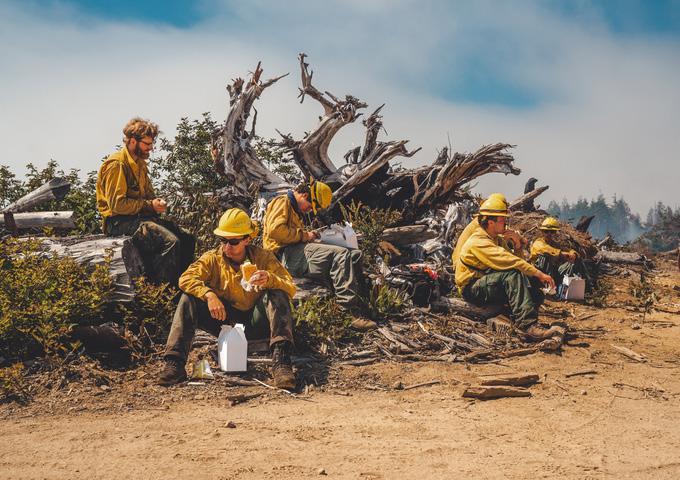
Dissertation Diaries Udathari
Kumarasinghe
Addison Dion
This installment of “Dissertation Diaries” highlights Udathari Kumarasinghe, a fifth-year Ph.D. candidate in the Department of Physics and Astronomy at Tufts University. Before Tufts, Kumarasinghe completed a Bachelor of Science in Physics at the University of Peradeniya in Sri Lanka.
Following completion of her undergraduate degree, Kumarasinghe knew she wanted to continue pursuing her passion for experimental physics. “I wanted to do … the Ph.D. program to just keep doing science,” she said.
Kumarasinghe was initially accepted into the lab of Cristian Staii at Tufts for her doctoral program, where she worked on experimental physics research. A year into her program, she began collaborating with David Kaplan’s laboratory, which focuses on biomedical engineering- and biophysics-related projects.
Biophysics is an interdisciplinary field that applies the research of physics to life sciences research, typically cellular processes. Now growing in importance due to the recent boom in biotechnological research, biophysics research is often used to develop new technologies for medical applications.
While this differed from her undergraduate focus, biophysics is a field that Kumarasinghe found struck a fine balance between learning new techniques and continuing with experimental science.
One of the emerging technologies in biophysics is cell therapy — the technique in which modified human cells are used to treat diseases.
Recent advances in research have demonstrated immense promise in the field. In a 2024 study, a Shanghai-based research group reported on their successful treatment of a man with Type 2 diabetes using insulin-producing islets derived from his own cells. Similarly, in a 2024 Nature “News” article, a woman with Type 1 diabetes was treated using her own stem cells, becoming able to regulate her own insulin.
“These pioneering studies demonstrate the potential of stem cells as a treatment for diabetes,” Dinesh Kumar and Rajni Tanwar, associate professors at the School of Pharmacy in Desh Bhagat University, wrote in a letter describing this research.
One issue in cell therapy is protecting the cells during transplantation, as cells will undergo immense mechanical stress, where internal forces are generated inside the cell due to external actions.
“They want to keep them alive and functional even after transplantation,” Kumarasinghe said. But how does one protect a fragile structure such as the cell?
Kumarasinghe first encountered the idea of encapsulation during her time in Kaplan’s lab, as it was something that provided a promising solution to the transplantation quandary in the cell therapy community.
Encapsulation, or in this case the surrounding of cells with a layer of synthetic biomaterial, is a technique being explored to remediate the issue of cell damage. Kumarasinghe sought to delve deeper into this topic for her thesis, applying her knowledge of experimental science to develop
The grind behind the grind
Midterm season is upon us all too soon; hopeful promises to ‘lock in’ loom large, and caffeine consumption reaches new heights, whether in the form of a tea, coffee, energy drink — or all three. Caffeine seems to transform from a fun little drink into a necessary ingredient in study routines. But, although we know that caffeine does in fact do something, the ways in which it works — and works less well the more you drink — can seem like a mystery. So, what’s the science behind the sip?
To understand the effects of disturbing a system, let’s first take a look at what normally happens in the brain. Adenosine — an organic compound similar to the nucleic acids present in DNA but missing certain phosphate groups — has been shown to be a key component in the regulation of sleep. It is important to note that sleep regulation is a complex system that involves many more pathways and molecules than just adenosine. However, one of caffeine’s primary mechanisms of action is heavily tied to adenosine,
a unique medium and method for encapsulation.
Using a technique called electrostatic layer-by-layer deposition, Kumarasinghe can artificially build a layer of the silk ionomer around the cell. The negative charge of the cell allows for the binding of a layer of positively charged silk ionomer, and in turn, a layer of negatively charged silk ionomer can be added on top of that. She can keep repeating this method until she has successfully encapsulated the cell, effectively providing a layer of protection to the cells from mechanical stress.
She can even test the success of her encapsulation with a variety of techniques, such as injecting the cells through screens to apply shear stress. According to Encyclopedia Britannica, shear stress is a “force tending to cause deformation of a material by slippage along a plane or planes parallel to the imposed stress.” These tests have demonstrated cell viability even after exposure to mechanical stress, indicative of a successful encapsulation.
In regard to cell therapy, Kumarasighe’s research holds promise in the protection of cells during transplantation. In order for cells to remain viable after transplantation, they must still be able to exchange molecules with the environment, such as insulin in the case of diabetes cells.
Therefore, a lot of Kumarasinghe’s recent work has centered around developing an encapsulation conducive to insulin exchange. An alternative to other encapsulation techniques, her silk ionomer membrane has potential concerning the successful transfer of insulin. Ultimately, it has the potential to be applied in cell therapy and biotechnological applications.
Despite her immense strides in the field of research during her
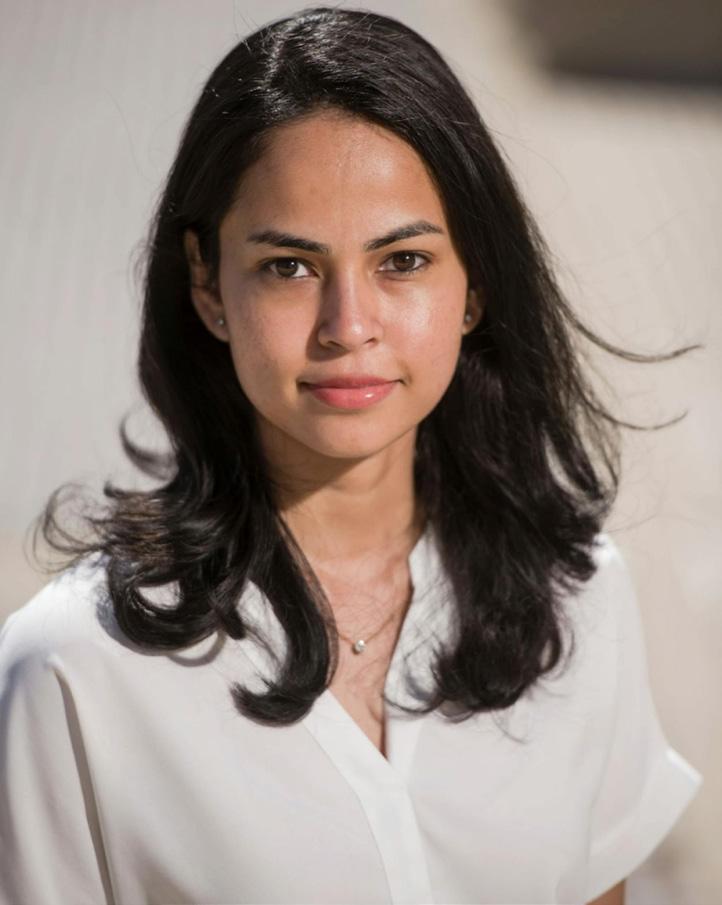
program, Kumarasinghe still faced numerous setbacks.
“It’s a long way to go,” she reflects on the demands of pursuing a doctoral degree.
One of Kumarasinghe’s biggest challenges was adjusting to a new environment. “Being an international student, missing home is a big thing,” she said. Despite this obstacle, she ultimately found community in the people she collaborated with daily, whether it be in the physics or biomedical engineering departments.
When asked if she had any final advice for aspiring Ph.D. candidates, Kumarasinghe advised students to push through feelings of imposter syndrome, saying that she had to constantly remind herself, “You have it. … You got into this program because you’re qualified for it.”
Addison Dion is a first-year who has yet to declare a major. Addison can be reached at addison.dion@tufts.edu.

and thus that is the focus of this article.
As you stay up longer, adenosine triphosphate — which you may recognize as the energy-rich molecule that helps power many biological processes within your body — accumulates. The body responds by degrading adenosine triphosphate into adenosine, leading to the increase
in concentration of adenosine. More adenosine molecules will thus bind to more adenosine receptors, and this stimulation has different exact mechanisms of action in varying brain regions. The overall effect, however, is that sleep is promoted by inhibiting wakefulness.
Caffeine has a very similar structure to adenosine and
thus is able to ‘fit’ in the adenosine receptors. Since caffeine will take up the space of an adenosine without stimulating the receptor, it prevents actual adenosine molecules from binding to their appropriate receptors and eventually has the effect of not promoting sleep — leading to the wakefulness that many crave caffeine for.
Continued caffeine consumption, however, eventually results in the production of more adenosine receptors in order to balance out the constant blocking of the ones you already have by caffeine. Because of this, it will now take more caffeine to similarly suppress your adenosine receptors — it will now take more caffeine to feel the same wakefulness. College can feel like a time when you’re always behind — always needing to write one more paper, study for one more test, go to one more event, add one more thing to your resume. Sometimes, it can feel like caffeine is the only way to keep up. The thing about caffeine is that it works well, until you suddenly need two energy drinks to feel as awake as you did with a single coffee a couple months ago. This is by no means a call to stop drinking caffeine — I, myself, am sipping a double-shot latte while writing this. But, maybe substitute your next Dunkin’ stop with a power nap, or pump up your adrenaline with a short workout instead of getting another energy drink. Take some time to recharge and reset your brain — before the caffeine slump causes your next crash out.
Tufts men’s soccer grinds out 1–1 draw with Wesleyan
Max Druckman Features Editor
Goal scoring can be artful, vivid and poetic. After glancing off the inner edge of a player’s cleat, the ball can be neatly curled, gently kissing the crossbar before settling into the top corner of the net. Other times, though, goal scoring can be ugly, scrappy and lucky. Still, no matter how a goal is scored, they all count the same. It was in the latter style that both Tufts men’s soccer junior forward Henry Brown and Wesleyan forward Sam Wheeler scored the only goals for their respective sides in a 1–1 draw on Bello Field on Saturday.
Saturday’s contest began with the Jumbos firing on all cylinders. They notched a corner kick and a shot on goal within the opening four minutes, repeatedly pressuring the Cardinals’ defense.
Junior winger Xavier Canfin exploited the Wesleyan retreat, charging down the right wing before looping a cross into the 18-yard box.
Next, the aforemen tioned ugly goal ensued. Brown redi rected Canfin’s airborne cross on target, but it hit the crossbar. Immediately, the ball was redirected right back at Brown’s head, after which it finally ended up past goal keeper Mathis Blanc for the game’s open -ing score.
“It felt good to get on the scoresheet early, I like to think I’m a big threat in the air but all the credit to my wingers for getting me consistent service,” Brown recalled in a message to the Daily.
Brown has been a revelation for the Jumbos thus far this season. Having started eight of the squad’s nine games, he is the team’s leading scorer with four goals. Brown’s swift inte gration into the Jumbos’ squad has been downright impres sive. After winning Liberty League Rookie of the Year in 2023 and Liberty League Player of the Year in 2024 at St. Lawrence University, the junior transferred into a Jumbo team that had gone undefeated in 2024 and waltzed right into the starting lineup. On his path to Medford, Brown turned down Division I offers from UMass Amherst and Lafayette College. Despite the unusual nature of his goal, it gave Tufts a launching pad from which to put more past the Wesleyan defense.
“The transition has been really smooth thanks to the people around me. The Tufts coaching staff has done an incredible job supporting me from day one,” Brown wrote. “My teammates have also

played a huge role by welcom ing me into the group and mak ing me feel part of the family

The pecking order of the Power 5
Just like everything else in college basketball, the pecking order of the top conferences seems to shuffle from year to year. With the constant churn of the transfer portal and a fresh round of coaching changes, this feels like the right moment to take stock of the Power 5. The
goal: to predict which leagues are poised for the most success, whether by racking up tournament bids, producing true championship contenders or simply standing out in overall competitiveness.
1. Southeastern Conference
One consistency is the SEC’s place atop the Power 5. After accumulating a record of 14 NCAA bids in 2025 (out of 16 SEC teams), the league’s top teams have reloaded. Reigning champions, Florida is back in contention with the No. 6 transfer class, while Kentucky came in just ahead at No. 5. Alabama, Auburn, Arkansas, Tennessee and Texas are all likely preseason top-25 teams. As 14 of the 16 schools sit in Bart Torvick’s
predicted top 50, depth and star power keep the league at No. 1.
2. Big 12
The Big 12 may not match the SEC’s volume of bids, but the top of this conference is loaded. Houston again has one of its best rosters under head coach Kelvin Sampson, while Brigham Young brings in a top-15 transfer class and expected No. 1 draft pick AJ Dybantsa. Texas Tech kept the 2025 Big 12 Player of the Year JT Toppin from their Elite Eight run. Also, Arizona and Iowa State project as top-tier teams. This firepower makes the Big 12 dangerous.
3. Big Ten
The Big Ten impressed in March, with all eight of its tournament teams reaching the sec-
ond round, matching the SEC’s total. They also match the SEC in the predictive rankings, notching 14 teams in Bart Torvick’s top 50. Gary Parrish’s “Top 25 and 1” features seven Big Ten teams, including two in the top 10. If the predictions hold, the league has a strong argument for the No. 2 spot.
4. Big East
After a strong stretch, the Big East looks headed for a dip. Just four teams crack Torvick’s top 50, the lowest in the Power 5. Coaching changes at Villanova and Xavier, plus limited portal success, leave most of the league scrambling. The exceptions are St John’s, with the No. 1 transfer class in the nation, and UConn,
returning a large portion of their 2025 squad. Both could be preseason top-five and are why the Big East ranks above the ACC. 5. Atlantic Coast Conference
The ACC has consistently fallen last in recent years. Once the sport’s premier league, it now offers only a few serious contenders. Duke remains elite with Torvick’s No. 2 ranking, and Louisville could be a real threat in March, but the rest of the league doesn’t offer much. Until the depth improves, the ACC is secure here at the bottom.
Owen Short is a senior studying quantitative economics. Owen can be reached at owen.short@ tufts.edu.
